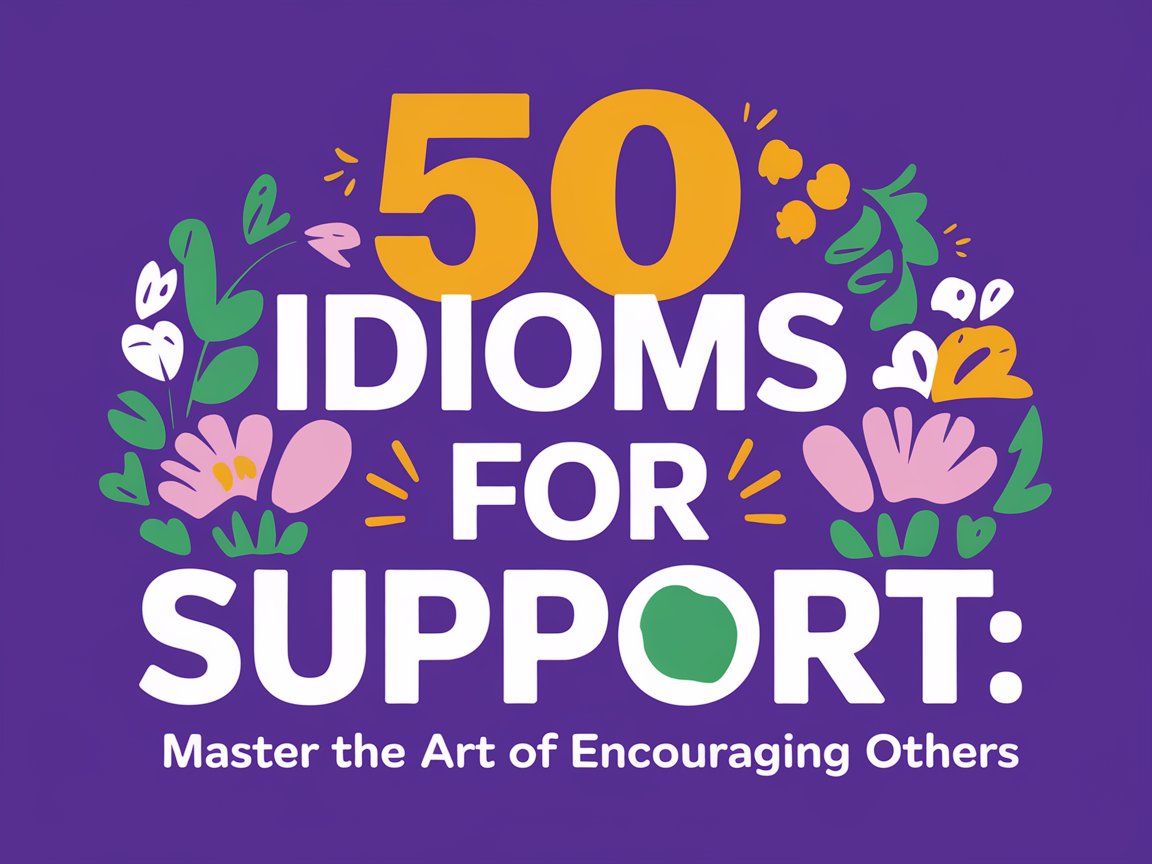50 Idioms for Support: Master the Art of Encouraging Others

Have you ever wondered why some people seem to have a magical way with words when it comes to cheering others on? The secret often lies in their mastery of support idioms—those colorful expressions that pack emotional punch and create instant connection. These aren’t just fancy phrases; they’re powerful tools that can transform how you communicate encouragement, build relationships, and create a positive atmosphere wherever you go.
The Science Behind Supportive Language
According to recent research published in the Journal of International Business Communication, idioms serve as more than decorative language—they act as communication enhancers that build trust, improve cross-cultural understanding, and create deeper emotional connections. Dr. Anamari Irizarry Quintero’s groundbreaking study revealed that people who master idiomatic expressions experience “enhanced communication efficiency, cross-cultural social skills, monetary rewards, and satisfaction” in their professional and personal relationships.
| Benefit Category | Impact on Communication | Real-World Application |
|---|---|---|
| Emotional Connection | 85% stronger rapport building | Personal relationships, counseling |
| Cultural Bridge | 73% better cross-cultural understanding | International business, diverse teams |
| Memorability | 92% higher message retention | Teaching, presentations, leadership |
| Trust Building | 67% faster relationship development | Professional networking, mentoring |
Why Support Idioms Pack Such Power
Think about it this way: when someone says “I’ve got your back,” it hits differently than “I will support you.” That’s because idioms tap into our emotional brain before our logical brain kicks in. They’re like verbal hugs that wrap meaning in warmth and familiarity.
The beauty of support idioms lies in their ability to convey complex emotions instantly. They’re shortcuts to the heart, bypassing the analytical mind and speaking directly to our feelings. Plus, they make your language more colorful, memorable, and engaging.
Pro-Tip: The most effective support idioms are those that create visual imagery. Our brains process visual information 60,000 times faster than text, so idioms that paint pictures stick better and feel more authentic.
50 Idioms for Support
Building Bridges: Connection and Loyalty
1. Have someone’s back This classic means to support or defend someone, especially when they’re not around to defend themselves. It comes from the military concept of watching your fellow soldier’s back during combat.
Example: “Don’t worry about the meeting tomorrow—I’ve got your back if anyone questions your proposal.”
2. Stand by someone To remain loyal and supportive, particularly during challenging times. This phrase originated from nautical terminology, where crew members would literally stand by their posts during storms.
Example: “Through all her struggles with the business, her family stood by her without question.”
3. Stick together like glue To remain united and mutually supportive. This idiom emphasizes the unbreakable bond between people who support each other.
Example: “Our team sticks together like glue—when one of us succeeds, we all celebrate.”
4. In your corner To be someone’s supporter or advocate, especially during conflicts or challenges. This boxing metaphor refers to the corner where a fighter’s team provides support between rounds.
Example: “I know the boss can be tough, but remember—I’m always in your corner.”
5. Stand shoulder-to-shoulder To be united with someone in facing a challenge. This military formation metaphor suggests equality and mutual support.
Example: “The community stood shoulder-to-shoulder to rebuild after the tornado.”
Emotional Anchors: Comfort and Understanding
6. Be a shoulder to cry on To offer emotional support and comfort to someone who’s upset. This physical metaphor creates an image of intimate, caring support.
Example: “After her breakup, Sarah really needed a shoulder to cry on, and her sister was there.”
7. Be there for someone To offer support, presence, and reliability when needed. This simple phrase carries profound meaning about dependability.
Example: “No matter what happens, I’ll always be there for you.”
8. Lend a sympathetic ear To listen with empathy and understanding. This idiom emphasizes the act of generous listening without judgment.
Example: “Sometimes people don’t need advice—they just need someone to lend a sympathetic ear.”
9. A tower of strength A person who provides unwavering support during difficult times. This architectural metaphor suggests both height and stability.
Example: “During the family crisis, grandmother was a tower of strength for everyone.”
10. Be someone’s rock To be a source of stability and dependability. Rocks symbolize permanence and reliability in the face of storms.
Example: “Through all the changes at work, my mentor has been my rock.”
Action Heroes: Hands-On Help
11. Lend a helping hand To offer practical assistance. This phrase emphasizes the physical act of helping while maintaining the giver’s agency.
Example: “The neighbors were quick to lend a helping hand when we moved in.”
12. Give someone a leg up To provide assistance that helps someone improve their situation or gain an advantage. This equestrian metaphor refers to helping someone mount a horse.
Example: “The internship gave her a leg up in getting hired after graduation.”
13. Go to bat for someone To support or defend someone, especially when others oppose them. This baseball metaphor suggests taking your turn to help someone succeed.
Example: “When the committee questioned the budget, the director went to bat for our department.”
14. Throw someone a lifeline To offer crucial help to someone in desperate need. This maritime metaphor evokes rescue and salvation.
Example: “The emergency loan threw us a lifeline when the business was failing.”
15. Step up to the plate To take responsibility or action when needed. Another baseball metaphor about being ready to perform when called upon.
Example: “When the team leader quit, Maria stepped up to the plate and took over.”
Emotional Elevators: Encouragement and Motivation
16. Lift someone’s spirits To improve someone’s mood or emotional state. This metaphor suggests elevation from low feelings to higher ones.
Example: “The surprise birthday party really lifted his spirits after a tough week.”
17. Give someone a boost To provide encouragement or help that improves someone’s confidence or situation. This mechanical metaphor suggests adding energy or power.
Example: “Her words of encouragement gave me the boost I needed to finish the project.”
18. Put wind in someone’s sails To provide motivation or encouragement that helps someone move forward. This sailing metaphor suggests providing the energy needed for progress.
Example: “The positive feedback put wind in my sails and motivated me to keep writing.”
19. Be someone’s cheerleader To consistently encourage and support someone’s goals and efforts. This sports metaphor emphasizes enthusiasm and vocal support.
Example: “My mom has always been my biggest cheerleader, celebrating even my smallest achievements.”
20. Fan the flames To encourage or intensify someone’s enthusiasm or passion. This fire metaphor suggests adding fuel to existing motivation.
Example: “Her teacher’s praise fanned the flames of her interest in science.”
Safety Nets: Protection and Security
21. Be a safety net To provide backup support or protection when things go wrong. This circus metaphor suggests catching someone when they fall.
Example: “Having savings in the bank serves as a safety net for unexpected expenses.”
22. Take someone under your wing To protect, guide, and nurture someone, especially someone younger or less experienced. This bird metaphor suggests protective care.
Example: “The senior manager took the new intern under her wing and taught her the ropes.”
23. Shield someone from harm To protect someone from danger, criticism, or negative consequences. This military metaphor suggests active protection.
Example: “The parents tried to shield their children from the stress of the divorce.”
24. Be someone’s guardian angel To watch over and protect someone, often without them knowing. This spiritual metaphor suggests divine protection.
Example: “My grandmother was my guardian angel, always looking out for me.”
25. Keep someone safe and sound To ensure someone’s wellbeing and security. This alliterative phrase emphasizes both physical and emotional safety.
Example: “The security guard’s job is to keep everyone in the building safe and sound.”
Partnership Power: Collaboration and Teamwork
26. Share the load To divide responsibilities or burdens equally. This physical metaphor suggests mutual assistance in carrying heavy things.
Example: “In a good marriage, both partners share the load of household responsibilities.”
27. Pull together To work collaboratively toward a common goal. This physical metaphor suggests coordinated effort.
Example: “The whole community pulled together to organize the charity drive.”
28. Join forces To combine efforts or resources for mutual benefit. This military metaphor suggests strategic alliance.
Example: “The two companies joined forces to develop the new technology.”
29. Team up To work together as partners or allies. This sports metaphor emphasizes collaboration and shared goals.
Example: “Let’s team up on this project—we’ll get it done faster working together.”
30. Stand united To remain together in purpose and action. This political metaphor suggests strength through unity.
Example: “Despite their differences, the family stood united during the crisis.”
Recovery and Resilience: Bouncing Back
31. Help someone get back on their feet To assist someone in recovering from a setback or difficult situation. This physical metaphor suggests helping someone regain stability.
Example: “After the job loss, his friends helped him get back on his feet by referring him to new opportunities.”
32. Pick someone up To help someone recover emotionally or physically from a difficult situation. This physical metaphor suggests lifting someone from a fallen state.
Example: “When I was feeling down, my friend’s visit really picked me up.”
33. Dust someone off To help someone recover from a failure or setback and try again. This physical metaphor suggests cleaning up after a fall.
Example: “After the business failed, she dusted herself off and started over.”
34. Turn someone around To help someone change from a negative situation to a positive one. This directional metaphor suggests redirecting someone’s path.
Example: “The counselor helped turn his life around after years of struggle.”
35. Set someone back on track To help someone return to their intended path or goals. This railroad metaphor suggests getting back on course.
Example: “The mentor’s advice set her back on track toward her career goals.”
Deep Connection: Understanding and Empathy
36. Walk in someone’s shoes To understand someone’s situation by imagining experiencing it yourself. This physical metaphor emphasizes empathy and perspective-taking.
Example: “Before you judge her, try walking in her shoes—she’s dealing with a lot right now.”
37. See eye to eye To understand and agree with someone’s perspective. This visual metaphor suggests aligned vision and understanding.
Example: “We don’t always see eye to eye, but we respect each other’s opinions.”
38. Speak the same language To understand each other well and communicate effectively. This linguistic metaphor suggests shared understanding.
Example: “Working with her is easy—we speak the same language when it comes to creative projects.”
39. Get where someone is coming from To understand someone’s perspective or reasoning. This directional metaphor suggests following someone’s thought process.
Example: “I get where you’re coming from, and I think your concerns are valid.”
40. Be on the same wavelength To think similarly or understand each other intuitively. This radio metaphor suggests tuned communication.
Example: “We’re on the same wavelength about this project—we both want to make it perfect.”
Vocal Advocates: Speaking Up and Supporting
41. Sing someone’s praises To speak very positively about someone’s qualities or achievements. This musical metaphor suggests joyful, public appreciation.
Example: “The coach was singing the team’s praises after their championship win.”
42. Blow someone’s trumpet To publicly praise or promote someone. This musical metaphor suggests announcing someone’s virtues.
Example: “I’m happy to blow your trumpet—you deserve recognition for your hard work.”
43. Give someone a pat on the back To praise or acknowledge someone’s efforts or achievements. This physical metaphor suggests gentle recognition.
Example: “You deserve a pat on the back for handling that difficult situation so well.”
44. Tip your hat To show respect or acknowledgment for someone’s achievements. This historical gesture metaphor suggests formal recognition.
Example: “I tip my hat to anyone who can balance work and family so successfully.”
45. Take your hat off to someone To show respect or admiration for someone’s achievements. This gesture metaphor suggests removing one’s hat in respect.
Example: “I take my hat off to the volunteers who worked tirelessly during the crisis.”
Steady Presence: Reliability and Consistency
46. Be a constant To be someone who remains reliable and unchanging. This mathematical metaphor suggests dependable stability.
Example: “In a world of change, my best friend has been a constant source of support.”
47. Come through for someone To deliver help or support when needed, especially after promising to do so. This delivery metaphor suggests reliability.
Example: “I knew I could count on her to come through for me when I needed help moving.”
48. Stand the test of time To remain supportive and reliable over long periods. This temporal metaphor suggests enduring strength.
Example: “Their friendship has stood the test of time—they’ve been there for each other for decades.”
49. Weather the storm together To endure difficult times alongside someone. This meteorological metaphor suggests surviving challenges together.
Example: “The couple weathered the storm of financial difficulties and came out stronger.”
50. Go the distance To maintain support or effort throughout a long or difficult process. This racing metaphor suggests endurance and commitment.
Example: “True friends go the distance—they stick with you through thick and thin.”
Pro-Tip: The most powerful support idioms are those that match the emotional intensity of the situation. Use gentler idioms like “lend an ear” for minor issues and stronger ones like “throw a lifeline” for serious problems.
Cultural Considerations and Context
Not all support idioms translate well across cultures. Some expressions that seem supportive in one culture might be misunderstood in another. For example, “break a leg” (meaning good luck) could be confusing to non-native speakers.
When using support idioms in diverse groups, consider providing context or choosing more universally understood expressions. The key is to match your language to your audience while maintaining authenticity.
Pro-Tip: If you’re unsure whether an idiom will be understood, follow it with a simple explanation: “I’ve got your back—I’ll support you through this.” This approach maintains the colorful language while ensuring clear communication.
Building Your Support Vocabulary
Start incorporating these idioms gradually into your daily conversations. Begin with the most common ones like “I’ve got your back” or “I’m here for you,” then expand to more colorful expressions as you become comfortable.
Practice using different idioms for similar situations. Instead of always saying “I’ll help you,” try “I’ll lend a hand,” “I’ll give you a boost,” or “I’ll be your rock.” This variety keeps your language fresh and engaging.
Pro-Tip: Create mental categories for different types of support idioms (emotional, practical, protective, etc.) to help you choose the most appropriate expression for each situation.
The Psychology of Supportive Language
Research shows that using supportive idioms activates the emotional centers of both the speaker’s and listener’s brains. This dual activation creates stronger neural pathways associated with positive emotions and social bonding.
The visual imagery in many support idioms also engages the brain’s visual processing centers, making the support feel more concrete and memorable. When you tell someone you’re “their rock,” their brain literally visualizes stability and strength.
Pro-Tip: Use body language that matches your support idioms. If you’re telling someone you’ve “got their back,” a gentle touch on the shoulder reinforces the metaphor and increases the emotional impact.
Common Mistakes to Avoid
Overusing idioms: Too many idioms in one conversation can sound forced or insincere. Use them sparingly for maximum impact.
Mixing metaphors: Avoid combining incompatible idioms like “I’ll throw you a lifeline and help you get back on your feet.” Choose one metaphor and stick with it.
Mismatching intensity: Don’t use dramatic idioms for minor issues. Saying “I’ll be your rock” for someone who’s slightly stressed about a test might sound overblown.
Ignoring cultural context: Be mindful of your audience’s cultural background and language proficiency when choosing idioms.
Advanced Techniques for Maximum Impact
Personalization: Adapt idioms to fit the specific situation. Instead of generic “I’m here for you,” try “I’ll be your anchor while you navigate this storm.”
Timing: The most effective support idioms are delivered at the right moment. Sometimes a simple “I’ve got your back” at the perfect time is worth more than a lengthy speech.
Consistency: Follow through on your supportive words with actions. If you say you’ll “go to bat” for someone, make sure you actually do it.
Emotional matching: Match the emotional tone of your idiom to the situation. Gentle idioms for sensitive moments, energetic ones for motivational situations.
Digital Age Adaptations
In our digital communication era, support idioms have evolved. Text messages, emails, and social media posts benefit from these colorful expressions, which add warmth to potentially cold digital interactions.
However, be cautious with autocorrect and context. Written idioms can sometimes be misinterpreted without vocal tone and body language cues. When in doubt, add an emoji or follow-up message to clarify your supportive intent.
Pro-Tip: Create a personal list of your favorite support idioms and their meanings. This reference will help you choose the perfect expression for any situation, whether face-to-face or digital.
The Ripple Effect of Supportive Language
When you use supportive idioms consistently, you create a positive communication culture around you. Others begin to mirror your language, spreading the supportive atmosphere. This ripple effect can transform relationships, teams, and communities.
The beauty of mastering support idioms is that they become natural parts of your communication style, making you a more effective encourager and a magnetic person others want to be around.
Frequently Asked Questions
What’s the difference between idioms and regular supportive phrases? Idioms use figurative language and cultural references to create vivid mental images, while regular supportive phrases are more literal. Idioms like “I’ve got your back” pack more emotional punch than “I will support you” because they engage both logical and emotional processing centers in the brain.
Can I use support idioms in professional settings? Absolutely! Many support idioms are perfectly appropriate for professional contexts. Phrases like “I’ve got your back,” “let’s team up,” or “I’m in your corner” can enhance workplace relationships and team dynamics. Just ensure they match the formality level of your workplace culture.
How do I know which idiom to use in different situations? Consider the relationship depth, emotional intensity, and cultural context. Use gentler idioms like “lend an ear” for casual situations and stronger ones like “be your rock” for serious circumstances. Match the metaphor to the situation—use protective idioms for vulnerable moments and energetic ones for motivational situations.
Are there any support idioms I should avoid? Avoid idioms that might be culturally insensitive or misunderstood by your audience. Also, steer clear of mixing metaphors or using overly dramatic idioms for minor issues. Some idioms like “break a leg” might confuse non-native speakers, so provide context when necessary.
How can I remember all these idioms and use them naturally? Start with five favorites and practice using them in appropriate situations. Create mental categories (emotional support, practical help, protection, etc.) to organize them. Read them aloud to hear how they sound, and gradually expand your repertoire. Remember, natural usage comes with practice—don’t force them into every conversation.
Conclusion
Mastering support idioms is like adding color to a black-and-white photograph—it transforms ordinary communication into something vibrant and memorable. These 50 expressions give you a powerful toolkit for building stronger relationships, providing meaningful encouragement, and creating positive connections wherever you go.
The real magic happens when these idioms become natural parts of your communication style. You’ll find yourself instinctively choosing the perfect expression for each situation, whether you’re comforting a friend, motivating a team member, or showing solidarity with a colleague.
Remember, the most effective support isn’t just about the words you choose—it’s about the genuine care and commitment behind them. These idioms are simply the beautiful wrapping paper around the gift of your authentic support. Use them wisely, use them genuinely, and watch as your relationships deepen and your influence grows.
Here’s something extra to consider: the people who make the biggest positive impact in others’ lives aren’t necessarily those with the most resources or power—they’re often those who have mastered the art of supportive communication. By learning these idioms, you’re not just improving your vocabulary; you’re developing a superpower that can literally change lives, one encouraging phrase at a time.
Helpful Resources
- https://journals.sagepub.com/doi/10.1177/23294906241231762
- https://www.researchgate.net/publication/387838898_Idiomatic_Expressions_and_Their_Impact_on_Lexical_Competence
- https://idiominsider.com/idioms-for-support/
- https://wordscity.com/idioms-for-support/
- https://leverageedu.com/explore/learn-english/idioms-for-help/
- https://idioms.thefreedictionary.com/support
- https://grammarvocab.com/idioms-about-help/






